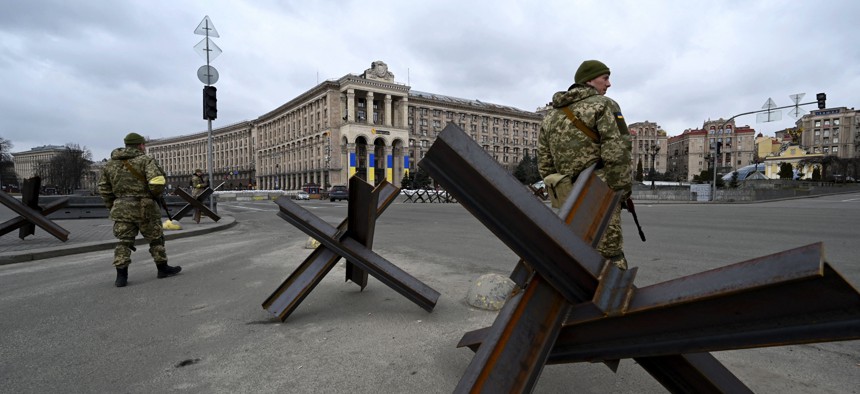
Members of the Ukrainian Territorial Defence Forces, the military reserve of the Ukrainian Armed Forces, stand guard next to anti-tank structures blocking the streets of the center of Kyiv on March 6, 2022. SERGEI SUPINSKY/AFP via Getty Images
Ukraine, Fight Your Fight—Not Their Fight
The Ukrainian military needs the weapons and tactics of an irregular conflict, not a conventional war.
Through nearly two weeks of fighting, Ukraine’s combat performance has surprised many. Ambushes and similar tactics, soldier-borne fires such as Javelins and M107 sniper rifles, and the sheer bravery of motivated regular troops, reserves, and civilians have exacted a significant toll on Russian heavy armor and mechanized and wheeled vehicles. Still, the Russian juggernaut slowly—many would say haphazardly—plods on to the center of gravity: the city of Kyiv.
Meanwhile, Ukrainian officials—and a significant number of Americans—are calling for no-fly zones, the transfer of Polish MiGs to Ukrainian pilots, and the creation of humanitarian corridors to evacuate civilians and bring in aid. But such tactics would change the nature of the fight from irregular warfare to a conventional match-up between Ukraine and Russia. This is a problematic strategy. The Ukrainians have demonstrated well-honed skill in these tactics, NATO allies are sending tons of vital equipment to them, and the fight is steady, albeit slow. To change course at this point may do more harm than good.
The alternative proposals suffer from downsides that are understood, but underappreciated. President Volodymyr Zelenskyy has condemned the United States and NATO—he said they have “blood on their hands”—for hesitating to create the no-fly zone and transfer high-performance aircraft. The potential for direct conflict with the Russians is acknowledged, but little is said of the real flaw in these proposals: they wouldn’t matter much. All available evidence suggests that Russian air operations are wreaking much less damage on defenders and civilians than are mortars, artillery and missiles. A no-fly zone would do little to change that—and might even cause the Russians to increase their use of indiscriminate indirect fire weapons.
As for the MiGs, objections have centered on the notion that Moscow would find this an escalatory step. What is relatively certain is that these advanced aircraft would likely induce Russia to introduce the S-400 air defense system to Ukraine and shortly thereafter down or ground the MiGs. Nor is it clear that Russian bombings of military airfields in Ukraine will leave the MiGs anywhere to fly from—except NATO airbases, which would draw the alliance into the conflict.
Lastly, the Russians appear amenable only to humanitarian corridors that lead into Russia and Belarus, countries unlikely to speed displaced Ukrainians to their desired destinations, nor facilitate aid from international aid organizations. These corridors can also be expected to lie alongside Russian supply lines, effectively making the refugees human shields, if not hostages.
So, how should the Ukrainians fight? The best way is to use partisan tactics, not try to slug it out with Russian conventional forces. When a speeding Tesla plays chicken with a slow-moving bulldozer, the bulldozer wins. As the Russian forces close in and encircle Kyiv, their soft underbelly will be the outer ring of that encirclement: logistics convoys, supply depots, artillery units, missile batteries and all of the massive support infrastructure. This is a rich target environment for snipers, Javelins, raids, ambushes and Stinger missiles. Like the tactics used by insurgents against U.S. forces for years in Iraq and Afghanistan, car bombs, IEDs, mortars, and other weapons of the weak can wreak havoc on a Russian force not yet protected by bases and walls.
The NATO nations, in particular the U.S., are conducting a brilliant resupply effort, bringing in Javelins, sniper rifles, and Stinger missiles along with tons of other equipment, but time is running short to support the second effort: urban warfare. In short order, the ring around cities such as Kyiv will tighten, and it is critical to get those defenders the equipment they will need to make the Russians pay dearly when they begin the tough, gritty, and deadly city fighting needed to take the capital. Mariupol may have already been lost, Odessa may be next, but Kyiv needs supply as fast as practicable.
To win the urban fight, the Ukrainians are at a natural advantage. They have deep knowledge of the terrain, have a doctrinal advantage (at least five to one, perhaps 10 to 1), and are training now for that battle. But they need equipment beyond Molotov cocktails and Kalashnikovs. One can only hope that NATO is bringing in advanced night-vision goggles, explosive charges, blasting caps, anti-personnel mines, grenade launchers, small mortars and Carl Gustav-like short-range anti-tank weapons. M21 sniper rifles are ideal for tight urban environments; anti-tank mines will punish the small number of tanks brave enough to wade into the fight. It is important that these and other key enablers get to the fighters before the cordons around the cities close.
These two battles—the irregular fight against the Russian “soft-belly” rear echelons and the urban combat needed when the Russians attempt to storm the cities—are the fights that must be won. These are the fight to choke off supply routes; destroy the logistics depots; defeat the artillery, missile, and rocket units bombarding the cities; and make the cities a death trap for the attacking Russians. These fights may be supported by Ukrainian MiGs and a NATO no-fly zone, but the risks of escalation, not to mention the questionable value of those efforts, should not divert the attention from the irregular and urban combat that will defeat the Russian forces or, at best, give the Russians a Pyrrhic victory. This can be done best by fighting a Ukrainian fight, not a Russian fight.
Mark Kimmitt, a retired brigadier general, is a former assistant secretary of state for political-military affairs and former deputy assistant defense secretary for Middle East policy. He consults for firms operating in the Middle East and Afghanistan.



